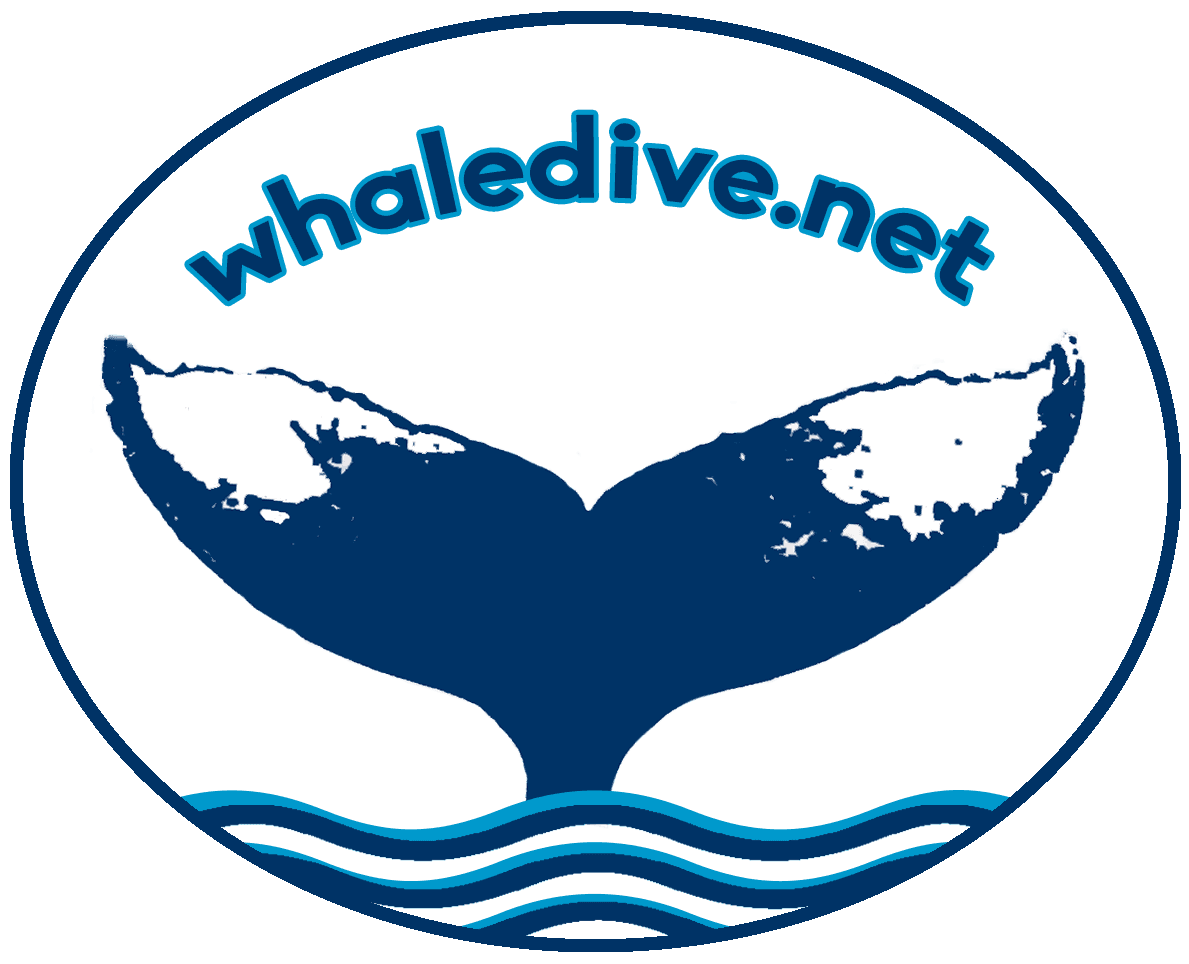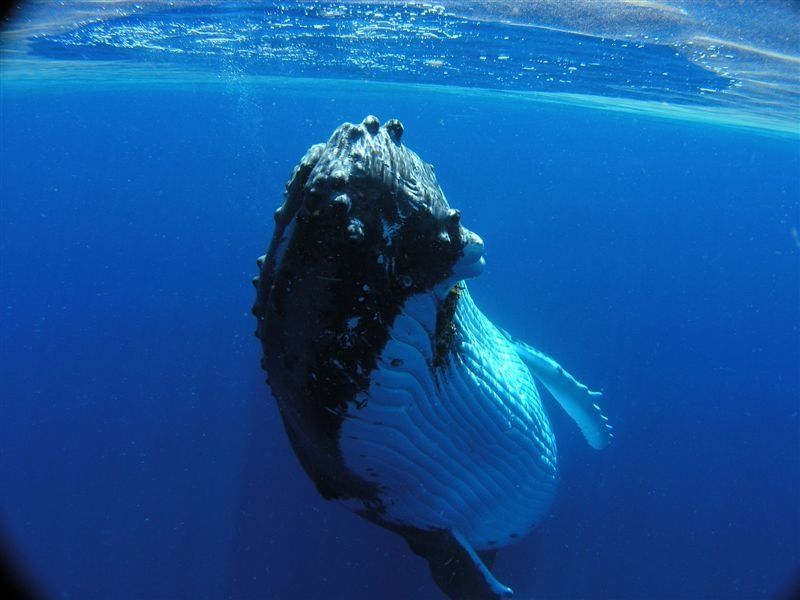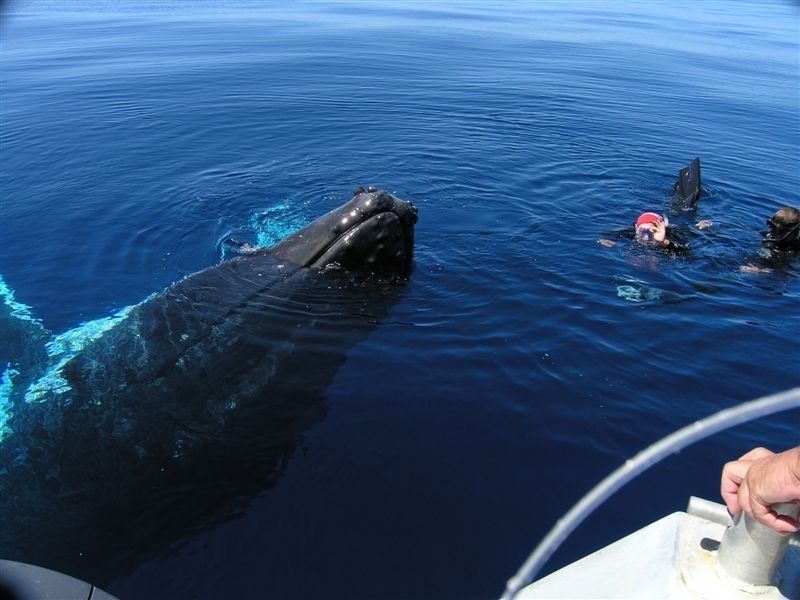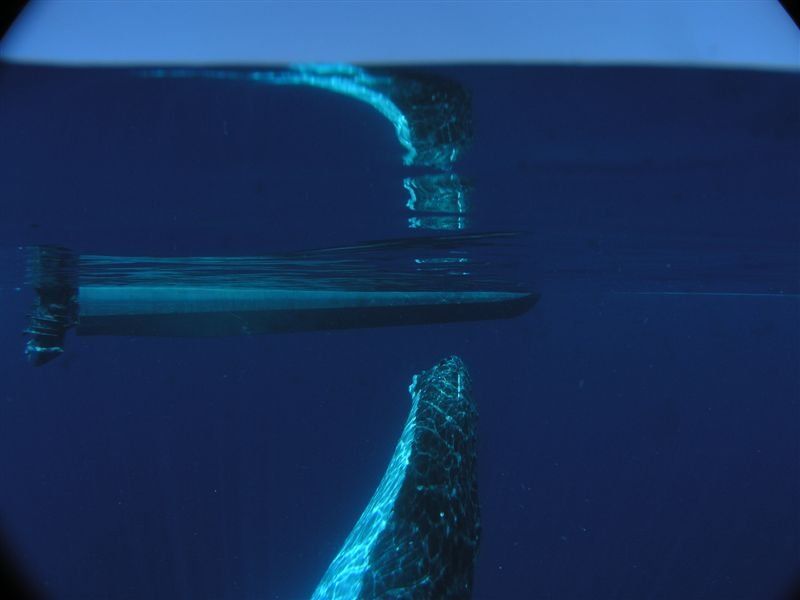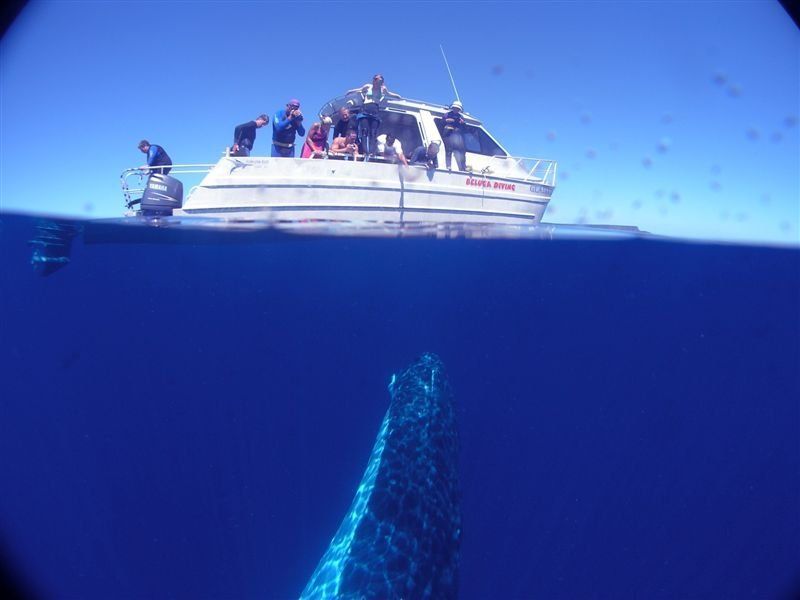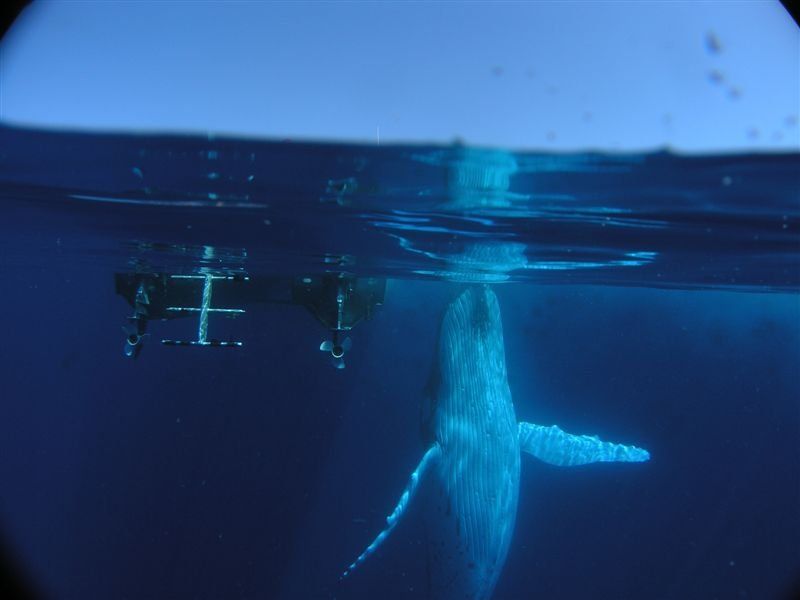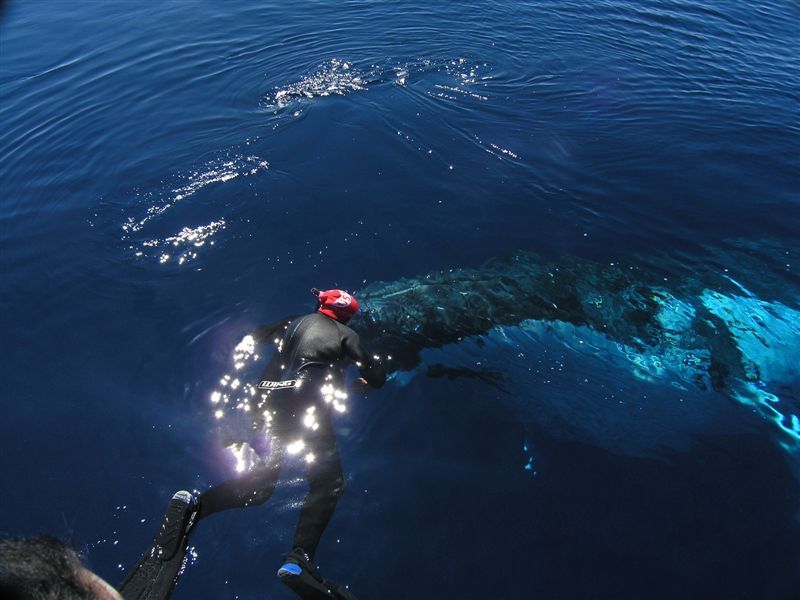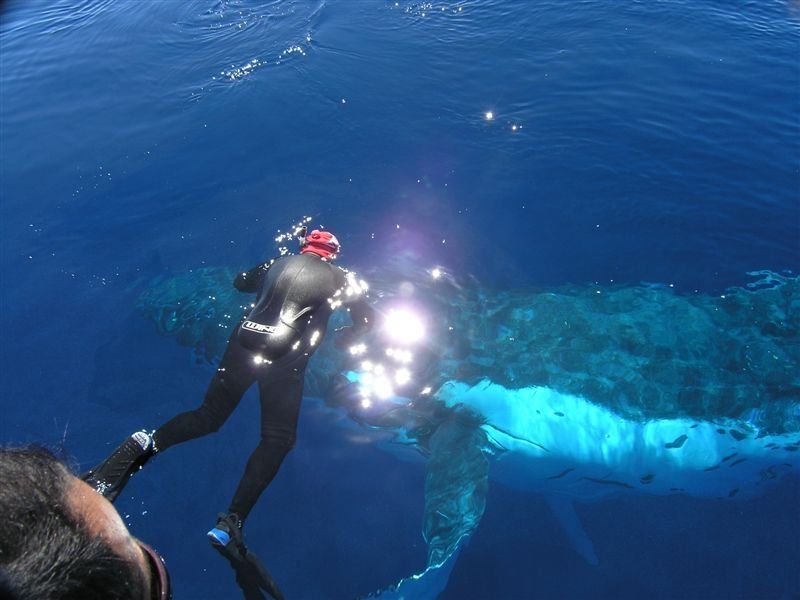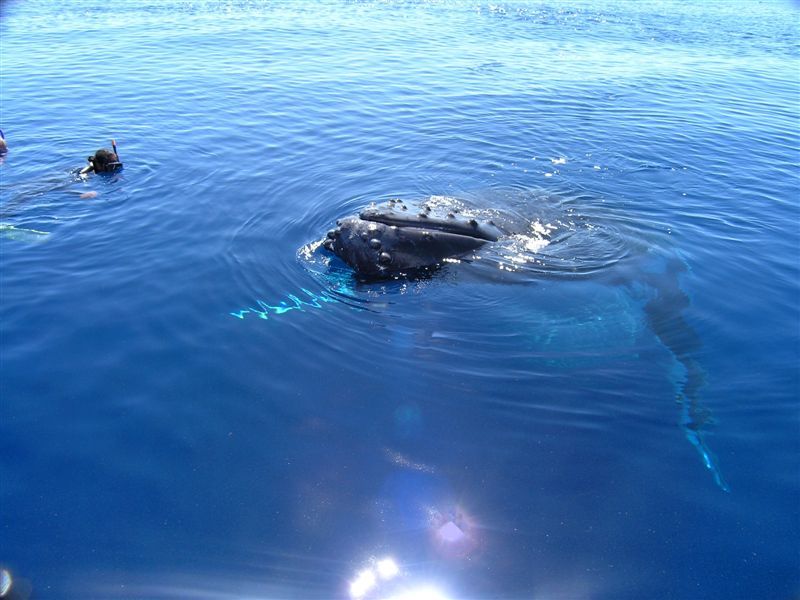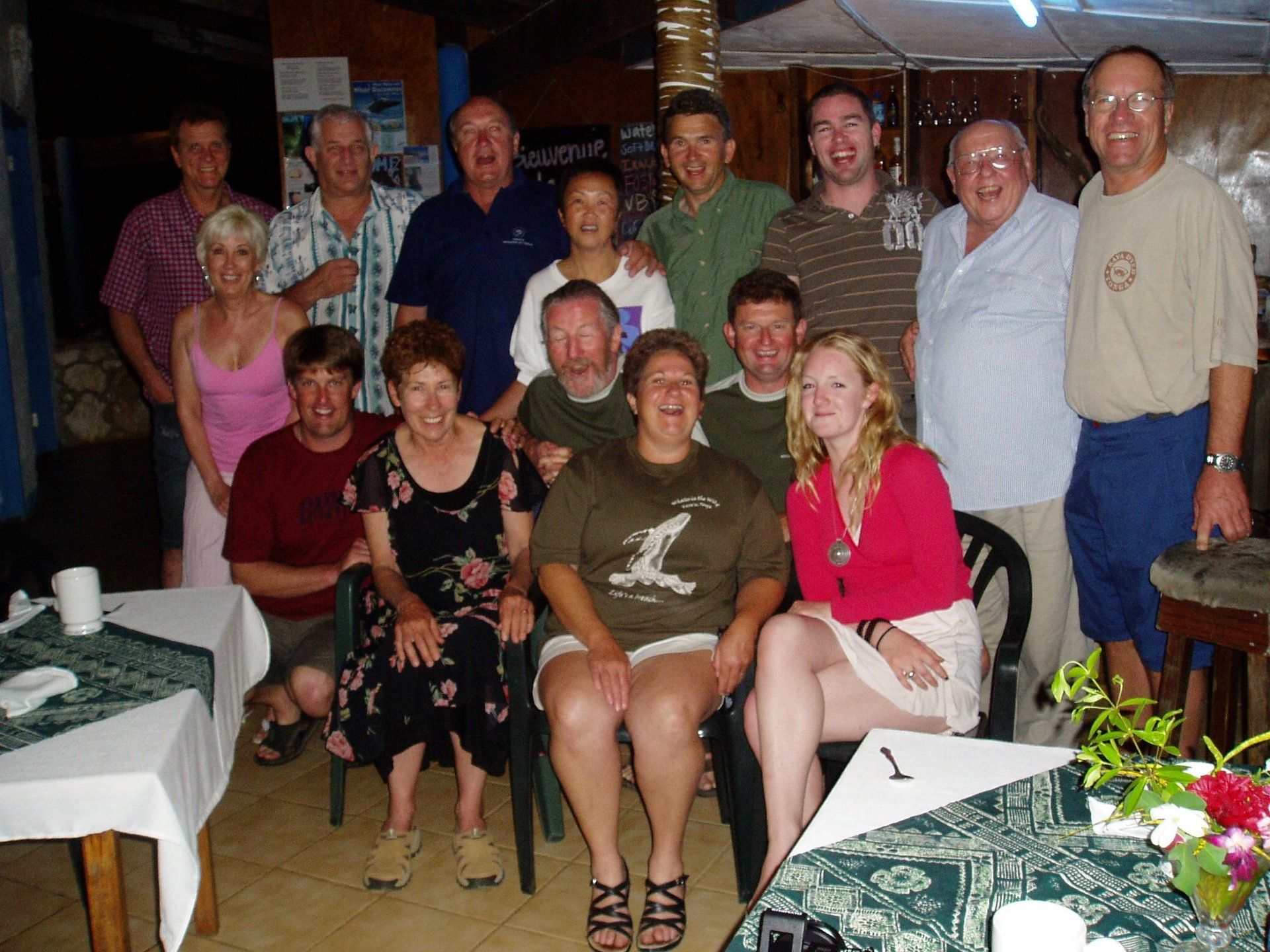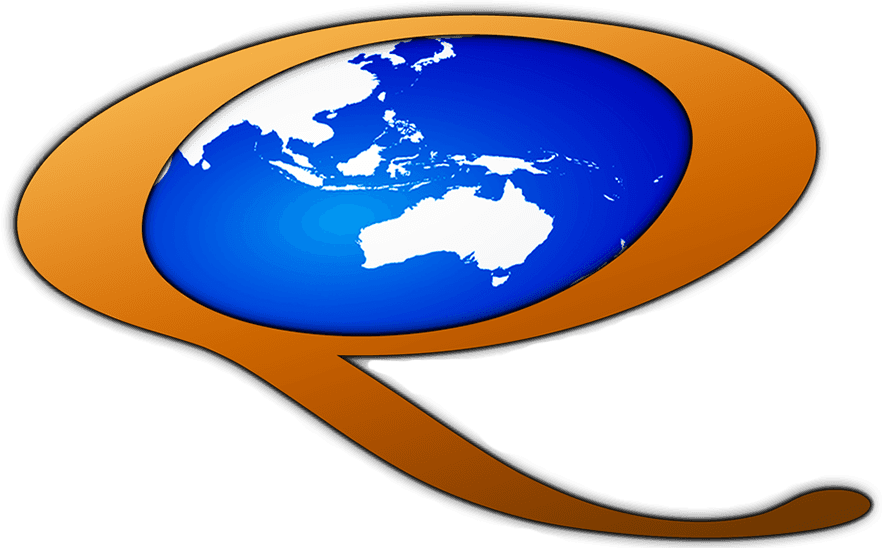2005
Swimming with Humpback Whales Vava’u – Tonga
By Ron Hunter of Dive Forster at Fisherman’s Wharf
August through September 2005, saw four groups from Dive Forster at Fisherman’s Wharf travel to Vava’u, the northernmost group of islands that are part of the Kingdom of Tonga archipelago.
This was our fourth year in a row visiting Vava’u to enjoy the superb Scuba diving there and best of all, to have the opportunity to swim with the Humpback Whales. These Whales travel to the archipelago to mate or give birth to their calves in the warm, sheltered waters found in and around the myriad of islands that make up the Vava’u group.
Our travellers to Vava’u now number over one hundred during the four years since I first discovered its delights in 2002, the year that I took the first group of Australian divers to visit and enjoy it all.
The siren song of the Humpbacks has not only drawn me back to Vava’u each year, but many of our travellers as well. One third of our travellers in 2005 were returning for the second and even third time in a row.
The tours are led by Whale, Dolphin and Shark experts Ron Hunter and David Hinshelwood, who ensure that all travelling to Vava’u with them have the best possible time both Scuba diving and during their encounters with the Whales.
Dive Forster at Fisherman’s Wharf has been conducting Whale Watching and Swimming with Dolphins Cruises for the last twenty years in Australia and during this time both Ron and David have come to be regarded as two of the foremost experts on Whales and Dolphins and their behaviour and interaction with people.
Interacting and swimming with some of biggest critters to ever inhabit Planet Ocean is an awe inspiring and humbling experience. Each day that we spent with the Whales in Tonga was entirely different, some of the encounters have become a talking point in the small, Whale orientated community of Vava’u, and others were so unique that they have instigated new conclusions in the studies of Humpback Whale / human interaction.
On one spectacular day we travelled around five miles offshore to check out a lot of breaching and tail slapping activity that we had sighted from near the island of Hunga. The South Pacific Ocean was over one kilometre deep here and the surface was a glassy calm with not a breath of wind to disturb the tranquility.
We had come upon a number of adolescents, three-quarters grown male Humpbacks. The pod numbered eight Whales and was accompanied by around thirty Spinner Dolphins. The Dolphins were alternately languidly circling our boat or diving down to the Whales, which were clearly visible, some thirty metres below the surface. We observed one of those unique sights, Spinner Dolphins “riding” the pectoral fins of the Humpbacks, this is an interaction between two distinctly different cetaceans that I had observed only once before, also in the waters of Vava’u.
The pod of Whales settled down as we cautiously motored up to them. Two of the Whales curiously approached our stationary boat. One of this pair of Whales “fell in love” with our boat. Our Tongan Whale guide, Felipe Tonga, has fifteen years of experience interacting with the Whales in these waters. Felipe was certain that this lovesick Whale was the same Whale from the previous season that had also “fallen in love” with one of the boats displaying mating behaviour towards it, which earned him the nickname of “Horny”.
“Horny” now displayed some quite usual Humpback Whale behaviour, spy hopping (raising the whole head until the eyes are clear of the water whilst being vertical in the water) right beside the gunwahl of the boat. The whale would alternate between this and swimming around the boat and the snorkelling divers, at times within one metre of people who were just floating on the surface.
One of our travellers, “Doc”, is in the habit of wearing a red and white St. George rugby league club beanie, even whilst diving or snorkelling in the tropics to prevent sunburn on his bald pate. “Doc” or his beanie apparently fascinated “Horny”, as every time “Doc” was in the water snorkelling, “Horny” would swim right up to him. On occasion the pair would be literally nose-to-nose right beside the boat.
This was to go one for over five hours with the snorkellers at times unable to get into or even out of the water because the Whale had stationed itself at the entry platform at the stern of the boat. At other times “Horny” would move at most ten metres away from our vessel, re-establishing contact with his companions and the snorkellers were now encircled by all eight Humpbacks, some of the Whales being on or near the surface and others resting twenty to thirty metres below.
After five hours we reluctantly left the Whales to return to the Port of Refuge and Beluga Dive Centre.
On our way back we were treated to the sight of around one hundred Pilot Whales accompanying our boat as we headed for shore. Diving, rolling and weaving all around our boat. The Pilot Whales had no difficulty in maintaining the twenty knots that we were travelling at, whilst we remained on a steady course for home. The Pilot Whales would come quite close alongside our boat, surfacing and establishing eye contact with us as we gazed in awe at their antics and athletic display This play and Whale / human interaction was to last for over thirty minutes before the Pilot Whales moved away from us as we came closer to land.
Wow! What a day!
Two of our seasoned travellers, both of whom have travelled to and dived nearly every desirable location in Australia and overseas, rated this and one other day that we swam with the Whales as the best two days they had ever spent in the water.
On another occasion we came upon a Humpback mother her, calf and an attendant male escort. We travelled with the slowly moving group for about thirty minutes and then once they were used to the boat they stopped, curious and adjacent to our boat. We slipped into the water and slowly snorkelled over to where they were and were thrilled to see the mother positioned stationary, vertical in the water with her nose around eight metres below the surface. Below the mother we could discern the escort lying horizontally some twenty-five to thirty metres below the surface. The calf was alternately hanging around mum’s head, feeding from the rich stream of milk that she exuded into his mouth, and surfacing to breath and curiously check out our group of snorkellers who were floating above.
The mother Humpback accompanied by the escort would surface to breathe every twenty minutes; you could almost set your watch by the timing of this. We were careful to position ourselves so as not to be in the way of their ascent, nevertheless nearly every time the adult Whales would alter their position during ascent, pirouetting as they rose. This caused a flurry of activity from the snorkellers who repositioned themselves to avoid being right on top of the Humpback’s noses as they broke the surface.
Swimming with the Humpback Whales in Tonga is a snorkelling only experience. The Whale Watch operators have a code of conduct that precludes Scuba diving with the Whales. Occasionally the Humpback Whales, not being aware of the code of conduct, will swim up to a group of Scuba divers during a dive. This happened a number of times to some of the groups this year.
One of these encounters began with the Scuba divers hearing incredibly loud “whalesong”, so loud in fact that it was vibrating their bodies, particularly their diaphragms. The divers were near the end of their time underwater and decided to swim out a bit from the island that they were diving against, at a depth of around five metres. All the while the “whalesong” was increasing in volume and intensity, gazing out into the blue they began to discern, at first, patches of white which soon materialized into two Whales. One of the Whales curiously swam right up to the now stationary divers, its approach was head on to within around four metres away, where it slowly turned, establishing eye contact with the mesmerized group, and then slowly swam away. The whole encounter lasted less than one minute, but what an awesome experience.
Another day I was Scuba diving with a group in around fifteen metres of water at Shark Tooth Cave, when I heard whalesong reverberating into the tunnel I was transiting. I hurried out of the cave system to see a Humpback mother and her calf slowly cruising by about ten metres away, too far for decent photography, but another awe inspiring encounter just the same. I swam out into the blue hoping that they would return but to no avail on this occasion. The rest of the group had heard the whalesong, somewhat muffled within the cave system, and did not react, thinking the whales were too far away. I was subjected to some dark mutterings once they joined me back onboard the dive boat and realised what they had missed.
Adventure and exploration diving is always on the agenda when we accompany groups on tours. Our opportunity for just this presented itself when a persistent low-pressure system that had funneled strong wind and rain squalls onto Vava’u, finally moved away from Tonga. Twelve months of anticipation and a good deal of patience by all was finally rewarded, as we ventured some twenty-eight miles out in the open ocean to the tiny island of Toku on a perfect, windless day.
This day a Tongan fisherman, Pafilio, a venerable, fit and very active gentleman of seventy-eight years of age, accompanied us. His tales of Toku and the big fish, sharks, drop-offs and many, many Whales that are found there, were irresistible lures to all of us. Pafilio has a lifetime of experience in the ocean waters off Vava’u, most weeks plying up to one hundred and twenty miles out to sea, for four day voyages in his 10 metre timber fishing boat that he built himself. He has made his living fishing the remote reefs and seamounts that dot this, otherwise abyssal deep, part of the South Pacific Ocean. We were very fortunate to have Pafilio onboard with his boundless knowledge of the ocean, her ways and the critters that dwell within it, locally in Vava’u he is much respected and treated as a living national treasure.
Our adventure to Toku was to be one of exploration diving and hopefully snorkelling with the Humpback Whales. After a passage of two hours we hove to on the sou’west side of Toku, sheltered there from the gentle, yet constant swells that marched in from the nor’east to wash Toku’s shoreline. Our post voyage, early morning cup of coffee was to be interrupted almost immediately by Whales breaching and spouting everywhere abeam of us in the sou’west to nor’west quadrants. (My apologies for sprouting nautical, but my scribing of this tale has been interspersed with reading a Patrick O'Brian novel about Captain Jack Aubrey and his sailing adventures in Nelson’s Royal Navy).
Hurriedly downing our cups of coffee, we donned wetsuits, fins and masks as our skipper Pafilio slowly motored over to a group of Whales. The group of Whales comprised a mother and her fairly young calf accompanied by a male escort.
The Whales very quickly settled down and became relaxed with the presence of our boat nearby. The young calf rolled playfully on her back and swam in loose figures of eight around her mother on the ocean’s surface. The mother Humpback slowly sank down to around eight metres under the surface where we could clearly see her in the bluest of blue water, underwater visibility this day was in excess of fifty metres, the calf gamboled around her mother’s head, whilst the escort moved slowly near the reef, which was clearly visible some forty metres below.
Five of us quietly slipped into the water and slowly finned over to the now stationary Whales. These three Whales were totally unconcerned by our careful, measured approach. The mother was now around five metres below the surface and her calf was surfacing, swimming joyfully around us, and then diving down to circle her mother’s huge head. The calf was now rubbing herself across the lumps on her mother’s nose; the coarse hairs that are used so much in communication between mum and her calf.
We swam with these three Whales for nearly three hours, leaving them still playing in the same area that we had across them before we moved off. We had a two-hour passage to make across open ocean to return to the Dive Centre.
Our next adventure out to Toku was several days later and on this occasion we once again came upon a mother and calf, but this time three male escorts accompanied them. These males Humpbacks were “singers”, and as they swam in an intricate, weaving pattern around twenty metres below us, their complex song was so loud it was literally vibrating our bodies. The mother and the calf all the while swam in lazy circle around our group of five snorkellers.
Our third and final day of adventure out to Toku was to be entirely different to our previous two expeditions. We came upon the same mother and her calf that we had swam with just the day before, this time the pair of them were unaccompanied. Our encounters with them were for only a few minutes at a time before the mother would move off closely accompanied by her calf. The pair were in relatively shallow water, no more than twenty metres deep, and as she moved off yet again we noticed a three metre Silver Tip Shark swimming nearby. Was this the reason for her agitation? All the while this was going on we could hear “whalesong” emanating from somewhere very close to us. The mother and calf moved out into deeper water and seemed to be more relaxed, so perhaps it was the close proximity of the Silver Tip Shark that had concerned her.
Nearby to our boat and on the opposite side to the mother and calf, two adult Humpbacks surfaced and we were then treated to a display of breaching and tail and pectoral fin slapping by two male “singers”. After around thirty minutes of this awesome display the two “singers” settled down and one of our team exclaimed they’re diving. And sure enough two massive Humpback Whale tails cleared the surface of the ocean and with water streaming off them they followed the bulk of the rest of the Whales below the surface. But this time, I noticed that there was something just a bit different, instead of going straight down the Whales appeared to twist during their action of diving.
The years of experience that I have gained in conducting Humpback Whale Watching, both in Australia and in Vava’u and these last four years swimming with the Humpbacks gave me an insight that these two Humpbacks had not dived very deep at all. I directed our skipper to position our boat so that the zephyr of a breeze would move our boat to a position near where we last sighted the two Whales. I then slipped into the water at the stern of the boat and there they were, directly under our boat and only about fifteen metres below the surface. The rest of our team slowly slipped into the water and hovered unmoving above the Whales as the boat continued to be blown gently away from where we were.
The two whales were once again “singing” and we all were floating there entranced by the complex pattern and rhythm of their song. This was a very special, emotional and fascinating encounter with two of the largest animals you could ever hope to interact with in the wild. After around twenty minutes the Whales, at first one and then almost immediately followed by the other, slowly began to rise towards the surface, turning and re-positioning their bulky bodies and long pectoral fins so as not to brush us, the now transfixed snorkellers.
The underwater photographs from these and the other encounters of 2005 are amongst the best anyone has ever achieved of Humpback Whales in the wild.
